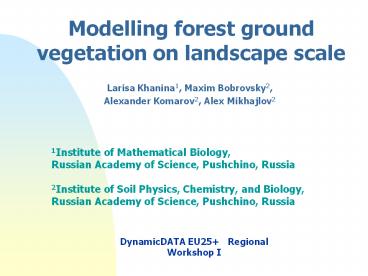Modelling forest ground vegetation on landscape scale - PowerPoint PPT Presentation
Title:
Modelling forest ground vegetation on landscape scale
Description:
Modelling forest ground vegetation on landscape scale Larisa Khanina1, Maxim Bobrovsky2, Alexander Komarov2, Alex Mikhajlov2 1Institute of Mathematical Biology, – PowerPoint PPT presentation
Number of Views:211
Avg rating:3.0/5.0
Title: Modelling forest ground vegetation on landscape scale
1
Modelling forest ground vegetation on landscape
scale
Larisa Khanina1, Maxim Bobrovsky2, Alexander
Komarov2, Alex Mikhajlov2
1Institute of Mathematical Biology, Russian
Academy of Science, Pushchino, Russia 2Institute
of Soil Physics, Chemistry, and Biology, Russian
Academy of Science, Pushchino, Russia
DynamicDATA EU25 Regional Workshop I
2
EFIMOD
3
At the first step
an approach an algorithm a
special software to calculate dynamics of ground
vegetation diversity at a level of forest stand
on a base of
Forest Inventory Data forest simulated
results
4
Our approach
plant species functional groups in ground
vegetation modelling ecological-coenotic species
groups
introduced in Nitsenko (1969)
Ellenbergs ecological indicator species values
Species ordination scores (by ordination of
phytosociological relevés)
Multivariate analysis
5
Results of multivariate analysis
ca. 1000 forest vascular species were split into
the functional groups
Boreal Vaccinium myrtillus, Maianthemum bifolium, Pyrola rotundifolia, Linnaea borealis
Nemoral Asarum europaeum, Aegopodium podagraria, Galeobdolon luteum, Milium effusum
Piny Vaccinium vitis-idaea, Pteridium aquilinum, Antennaria dioica, Calluna vulgaris
Nitrophilous Aconitum septentrionale, Stellaria nemorum, Urtica dioica
Meadow Fragaria vesca, Alchemilla sp., Dactylis glomerata
Water/Olg Caltha palustris, Typha angustifolia, Carex globularis
6
To use the groups for modelling dynamics of
ground vegetation
to define the dominant group at the initial
step of simulation to define rules of the group
switching according to dynamics of the
simulated parameters
tree species composition, light supply,
deadwood volume, litter, soil fertility and
moisture
7
Definition of dominant species groups at the
initial step
Forest Inventory Data
Dominant species in ground vegetation
?
Database on ecological-coenotic groups of plant
species
Dominant group(s) in ground vegetation
8
Definition of dominant species groups at the
initial step
9
Forest type biodiversity assessment
Forest Type Tree dominant Dominant group in
ground vegetation
Vegetation Sample Plots Data
- Forest type biodiversity indices
- Average number of plant species per square unit
- Functional structure of ground vegetation
10
Modeling of forest groundvegetation
11
BioCalc - a software for dynamic analysis of
forest ground vegetation diversity
12
BioCalc input data
tables of probabilistic distribution of the
groups in ground vegetation according to the tree
dominant and the forest site index a
correspondence table between a forest type and
species diversity rank a time series table of
forest stand ecosystem parameters (EFIMOD runs)
13
Rules of functional groups switching
User of the BioCalc software selects from the
time series tables in an interactive mode
thresholds for a number of ecosystem parameters.
Reaching these thresholds causes a change of
the dominant ecological-coenotic group. The
user can observe all values of any ecosystem
parameter displayed graphically
14
Rules of functional groups switching
If the values are digital, a graphic is built
where the values go in ascending order, which
allows for easy detection of the thresholds
15
BioCalck outputs
Dynamics of ground vegetation functional
groups, forest types, and species
diversity ranks
A link with Common-GIS (Andrienko, Andrienko,
1999) for visual exploration of ground vegetation
dynamics at the landscape level
16
A case study experimental forestryRusskii Les
273-hectare forest lot with 104 stands
Four strategies of silvicultural regimes for 200
years time span natural development leg
al clear cutting selective
cutting illegal clear cutting
17
Case study rules of functional group switching
- (i) meadow group switched to boreal group when
spruce began to dominate in overstorey - (ii) any group switched to nemoral when oak began
to dominate in overstorey - (iii) piny group switched to boreal group when
deadwood overpassed the 1st threshold value - (iv) any group switched to nitrophilous group
when deadwood overpassed the second threshold
value, and - (v) nitrophilous group switched to nemoral group
when deadwood fell below the 2nd threshold value
18
Case study rules of functional group switching
- In the scenarios with clear cuttings
- after the clear cutting, a dominant group was
taken from a specially designed probabilistic
table of the group distribution in ground
vegetation designed for the after-clear-cutting
conditions
19
Tree dominant dynamics
Selective cuttings
Natural development
Illegal clear cuttings
Legal clear cuttings
20
Tree dominant dynamics
200-year dynamics
Legal selective cutting
Natural development
The beginning
Legal clear cutting
Illegal clear cutting
21
Deadwood dynamics
22
Functional group dynamics
Natural development
Legal selective cuttings
Legal clear cutting
Illegal clear cutting
23
Functional group dynamics
200-year dynamics
Legal selective cutting
Natural development
The beginning
Legal clear cutting
Illegal clear cutting
24
Species diversity dynamics
25
Species diversity dynamics
200-year dynamics
Legal selective cutting
Natural development
The beginning
Legal clear cutting
Illegal clear cutting
26
Tree dominant dynamics regional level
50-year dynamics
1 Pine, 2 Spruce, 3 Birch, 4 Aspen I initial
state, II legal clear-cutting, III natural
development
27
Functional group dynamics regional level
50-year dynamics
I initial state, II legal clear-cutting, III
natural development
28
Species diversity dynamics regional level
50-year dynamics
1, 2, 3, 4, 5 ranks of species diversity I
initial state, II legal clear-cutting, III
natural development
29
EFIMOD parameters for ground vegetation dynamics
used tree composition deadwood in progress
humus amount nitrogen amount in plan light
soil moisture
30
Thank you for your attention!































